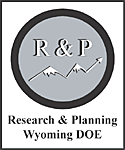Seasonally Adjusted Unemployment Rate Rises to 5.9% in June
From May to June Wyoming added 7,200 jobs, or 2.5%. This is somewhat smaller than the normal seasonal increase of approximately 9,800 jobs. Seasonal job gains were seen in retail trade (1,000 jobs, or 3.2%), professional & business services (500 jobs, or 2.8%), educational & health services (400 jobs, or 1.6%), and leisure & hospitality (5,000 jobs, or 15.2%). Employment decreased in natural resources & mining (-200 jobs, or -0.8%), construction (-100 jobs, or -0.4%), and government (including public schools, colleges, and hospitals; -200 jobs, or -0.3%).
Over the year, employment decreased by 7,900 jobs, or 2.6%. The largest job losses occurred in natural resources & mining (including oil & gas; -3,500 jobs, or -11.9%) and construction (-3,500 jobs, or -11.9%). Employment also decreased in professional & business services (-1,100 jobs, or -5.6%), leisure & hospitality (-1,000 jobs, or -2.6%), and retail trade (-400 jobs, or -1.2%). Job gains were seen in educational & health services (500 jobs, or 2.0%) and government (including public schools, colleges, & hospitals; 1,400 jobs, or 2.0%).
Unemployment rates in Wyoming’s 23 counties all increased from their 2008 levels. The highest rates were found in Big Horn (7.9%), Fremont (7.4%), Lincoln (6.7%), and Johnson (6.7%) counties. Albany and Sublette counties posted the lowest unemployment rates (both 4.2%) followed by Teton County (4.7%).
1Seasonal adjustment is a statistical procedure to remove the impact of normal regularly recurring events (such as weather, major holidays, and the opening and closing of schools) from economic time series in order to obtain a better understanding of changes in economic conditions from month to month.
